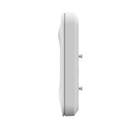High-speed dual-band Wi-Fi
The device supports 2.4GHz and 5GHz dual-band communication, providing access rate of 574Mbps at 2.4GHz, 1201Mbps at 5GHz and up to 1775Mbps per AP. It can provide 5GHz frequency band with less interference, wider channel, and faster speed for the terminals, allowing the users to enjoy excellent wireless experience.
Dual LAN ports design
The device adopts the dual LAN ports design. Even for complex networking requirements, it can easily and quickly support the expansion of third-party devices, such as cameras, time and attendance devices, etc.
Support routing and AP mode
The device supports both AP and routing mode. A wireless network can be formed with multiple APs, or it can be used as a wireless router when deployed independently. The device offers more flexible configurations, more abundant application features, and more extensive applicable scenarios.
Support Layer 3 roaming
The device supports Layer 3 roaming for the complex Layer 3 network. When users move across the Layer 3 networks, seamless roaming can be achieved without service interruption.
Stronger and more stable signals
An aluminum alloy antenna reflector is added to reflect interference signals and focus effective signals so as to provide stronger signal transmission and better receiving sensitivity.The device uses FBAR to filter out most of interferences caused by the operator's base stations, microwave ovens, Bluetooth devices, etc., so as to provide cleaner wireless signals, higher transmission rate and more stable transmission quality.
Robust casing
With the robust and flame-retardant material of the AP casing, the impact resistance is 5 times higher than that of common ABS plastic materials. The tensile and flexural strengths are increased by 30%, which is not easy to damage. Users can rest assured during usage and maintenance.
Simple installation
It supports various installation methods including on desktop, ceiling, wall, and pole. Adopting the non-directional installation design, the equipment can be installed in one go efficiently.
Industrial design
The industrial product design, iconic edges and breathing light makes the product more recognizable.
Multi-end management
The AP supports management via Ruijie Cloud app, Ruijie Cloud platform, equipment EWEB management to achieve multi-end local and remote management on PC, Ruijie Cloud app.
Fast and smart configuration
In large-scale complex networks, the configuration of the entire network can be completed by connecting to a single gateway device. There is no need to configure the devices separately, which can greatly reduce the device configuration time.
Scenario-based configuration
Scenario-based configurations can be performed via the web and Ruijie Cloud app, which can greatly reduce the configuration threshold of complex functions, such as visitor isolation solution, flow control solution, etc. Even novices can easily fulfill the diverse and complex requirements of the customers.
Visualized operation and maintenance
The cloud computing network topology can comprehensively present the equipment operating status of the entire network. Through the rich information in the topology, you can quickly get the full picture of the network (network egress status, link status, device status), and quantify the user experience and network quality, so that users can master the information of the entire network.
Remote collaborative management
Users can perform comprehensive remote operation, management, and maintenance of the equipment in the entire network via the Ruijie Cloud app, Ruijie Cloud platform, etc. They can also share the network to third party for network hosting and collaborative management to operate and maintain the enterprise network more efficiently.
AI & big data network optimization
Through artificial intelligence and cloud big data, the AP can perform comprehensive smart network operation, maintenance and optimization, including but not limited to:
1. Automatic identification of new equipment and adding it into the network, automatic system repair such as avoiding conflict of the WAN IP addresses.
2. Smart system optimization such as service-based network policy configuration, RF channel and roaming adjustment
3. Diagnosis and repair suggestions for more than 30 common network anomalies including DHCP conflicts, abnormal negotiation rates, excessive traffic, AP disconnection and device interference.














